I am interested in fluid dynamics, nonlinear phenomena, instabilities turbulence and waves, mixing, especially in stratified and/or rotating flows as well as convective flows or microfluidic flows.
In particular my previous work in Oxford and Lyon was to understand atmosphere dynamics by performing laboratory experiments and numerical simulations.
Currently, I investigate experimentally (at ILM, Lyon) the influence of microscopic phoretic effects on macroscopic mixing.
Influence of microscopic phoretic effects on macroscopic mixing. (see ANR project Tunamix)
This project aims at exploring how novel local-scale mechanisms can be harvested to control macro-scale mixing of particles and macromolecules. While usual strategies to improve mixing generally consist in stirring the fluid to promote advection and compensate the low efficiency of molecular diffusion, we investigate the small-scale mobility of the mixed entities by exploiting phoretic «environment sensing» phenomena. Practically these phoretic mechanisms can be as simple as colloids responding to a weakly inhomogeneous chemical or thermal background, and as generic as swimming microorganisms in oceans or bio-reactors. For instance the group at ILM has shown that diffusiophoresis (enhanced mobility in presence of chemical gradients) can enhance by order of magnitudes (compared to simple Brownian diffusion) the effective mobility of colloids in presence of controlled salinity gradients.
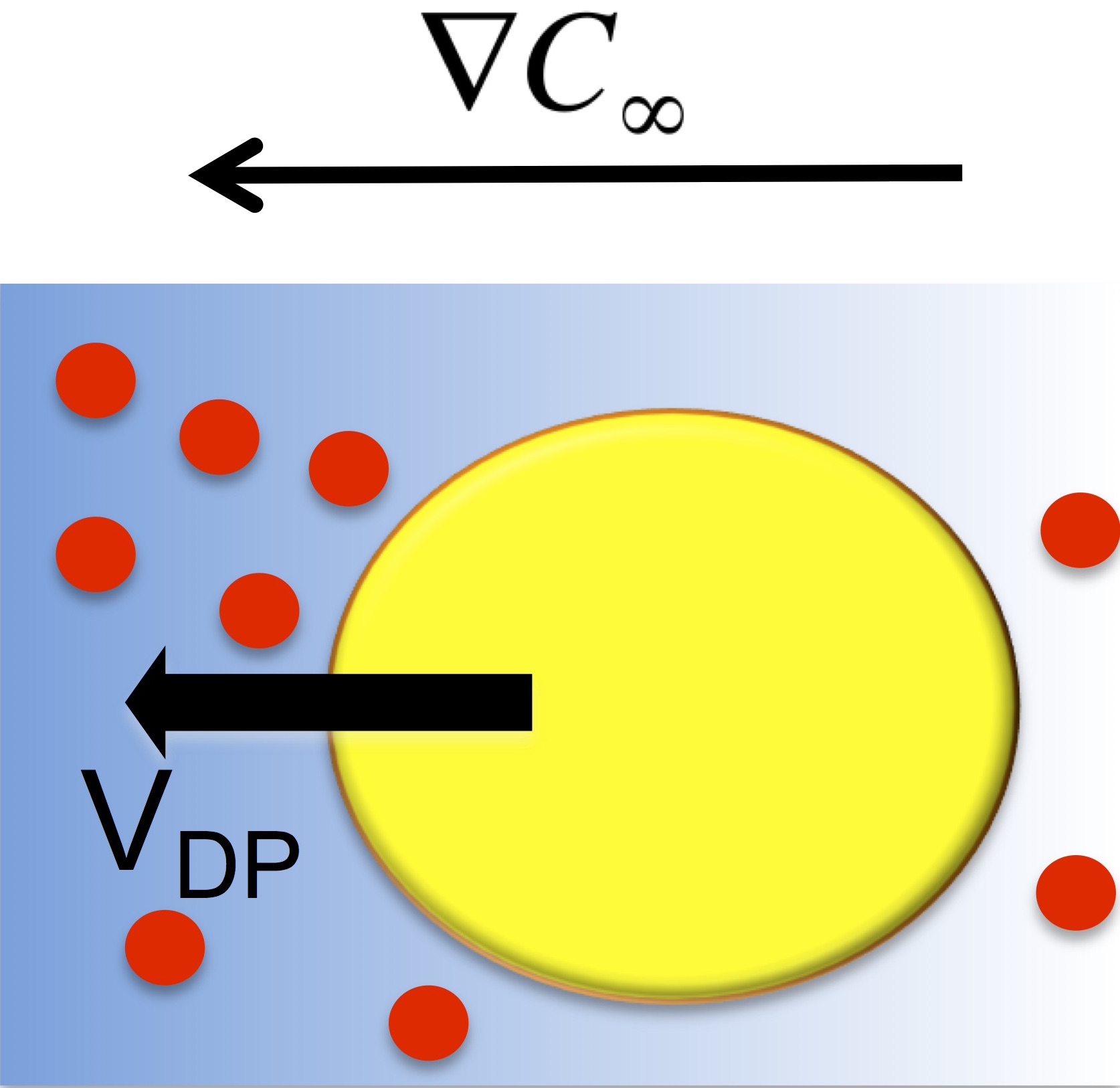
A colloïd (solid particle) in a fluid composed of a gradient of a solute (salt) can acquire an additional diffusiophoretic Vdp related to the gradient of log of the salt concentration.
Nonlinear Equilibration and Turbulent Cascades in laboratory Studies of Baroclinic Turbulence ( EPSRC grant )
Complex interactions between turbulent convection and stably-stratified flows in the presence of background rotation are important for a wide range of problems in various engineering contexts, in atmospheric and oceanic science, and in stellar and planetary astrophysics. Here I am investigating in Oxford with Peter Read the nature of flows between a heat source and a heat sink that are displaced both vertically and horizontally relative to each other, in the presence of strong background rotation.
In the absence of background rotation, if a heat source is located at a lower altitude than the sink, one would generally expect a strongly convective circulation to result, carrying heat directly and vigorously from the source to the sink. With background rotation, however, evidence from experiments, simulations and in geophysical flows suggest that the resulting circulation may spontaneously partition itself into a convectively unstable/neutral region (where temperature becomes well mixed and does not vary much with height) that interacts with a statically stable, so-called baroclinic region (where temperature increases with height and develops a thermal gradient from one side to the other). Wave-like instabilities may develop within this baroclinic zone that may play a crucial role in stabilising the vertical stratification and dominating the transfer of heat and momentum where they occur. Moreover, there is evidence to suggest that if the transport of heat by the instability acts more rapidly than other heat exchange processes, this stabilizing effect may act within a nonlinear feedback loop, somewhat like a thermostat, adjusting the flow back towards a weakly nonlinear/unstable 'critical' state - sometimes referred to as 'self-organized criticality'. Such strongly nonlinear and convective motions are difficult to model accurately, however, so the mechanisms involved, though probably ubiquitous in certain engineering systems and in nature, are not well understood.
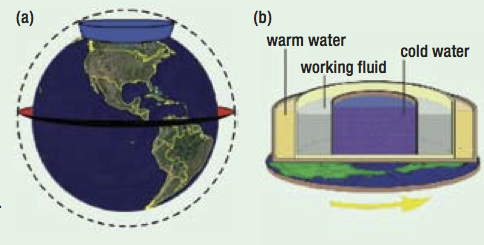
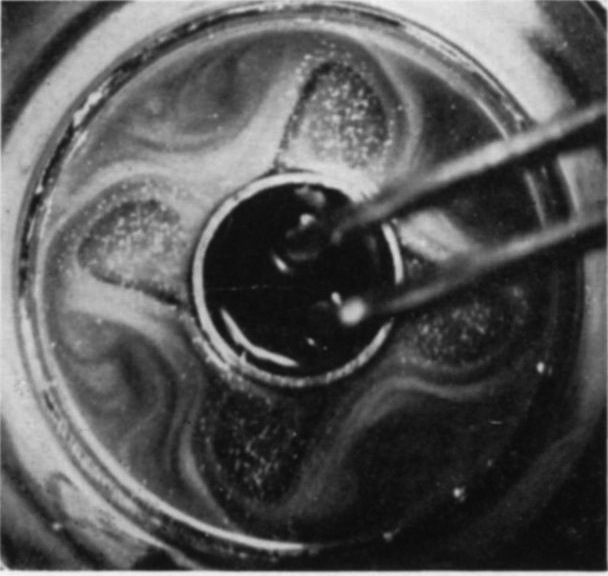
Differentially wall-heated annulus experiment showing baroclinic instability similar to
atmosphere dynamics in midlatitudes.(From Ghil et al A&G 2010 vol 51 (4)) )
During this post-doc, my first work was to design a laboratory analogue of the rotating, stratified flow configuration mentioned. The new experimental configuration entails heating a body of fluid in a cylindrical container on a rotating platform along an annular ring at the bottom of the tank close to the outer radius, and cooling it through a circular disk near the centre of the tank at the upper surface. Such an experiment is a variant of the classic differentially wall-heated annulus experiment initially used by Hide (1953) showing baroclinic instability similar to atmosphere dynamics in midlatitudes. However it now removes constraints placed on background temperature gradients in the fluid and should allow the formation of a statically stable (though baroclinically unstable) zone between convectively unstable regions over/underlying the heated or cooled boundaries.
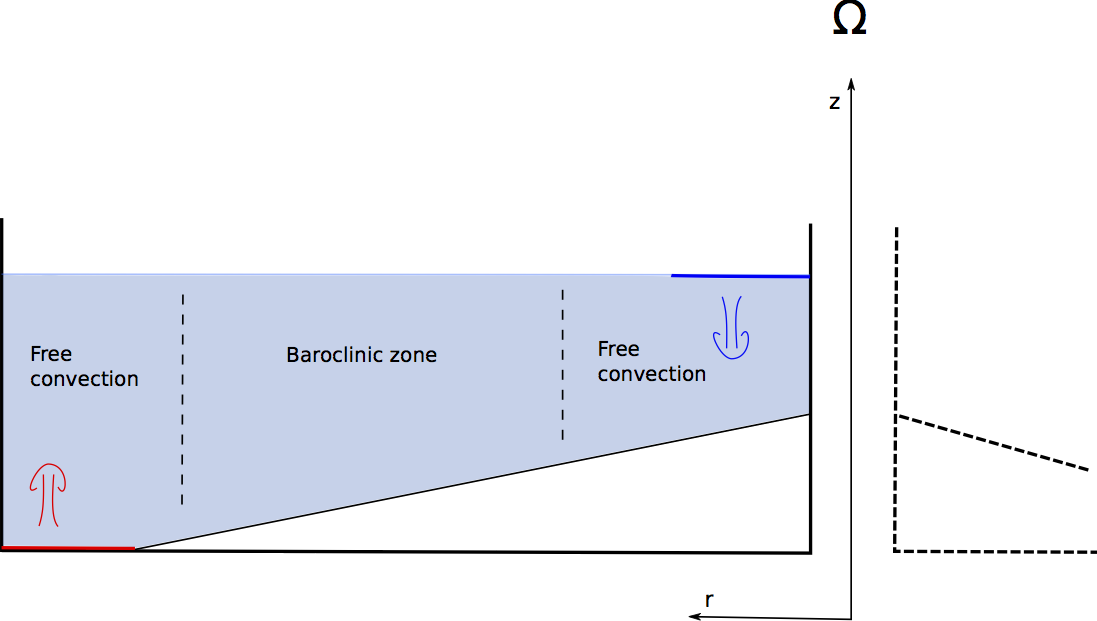
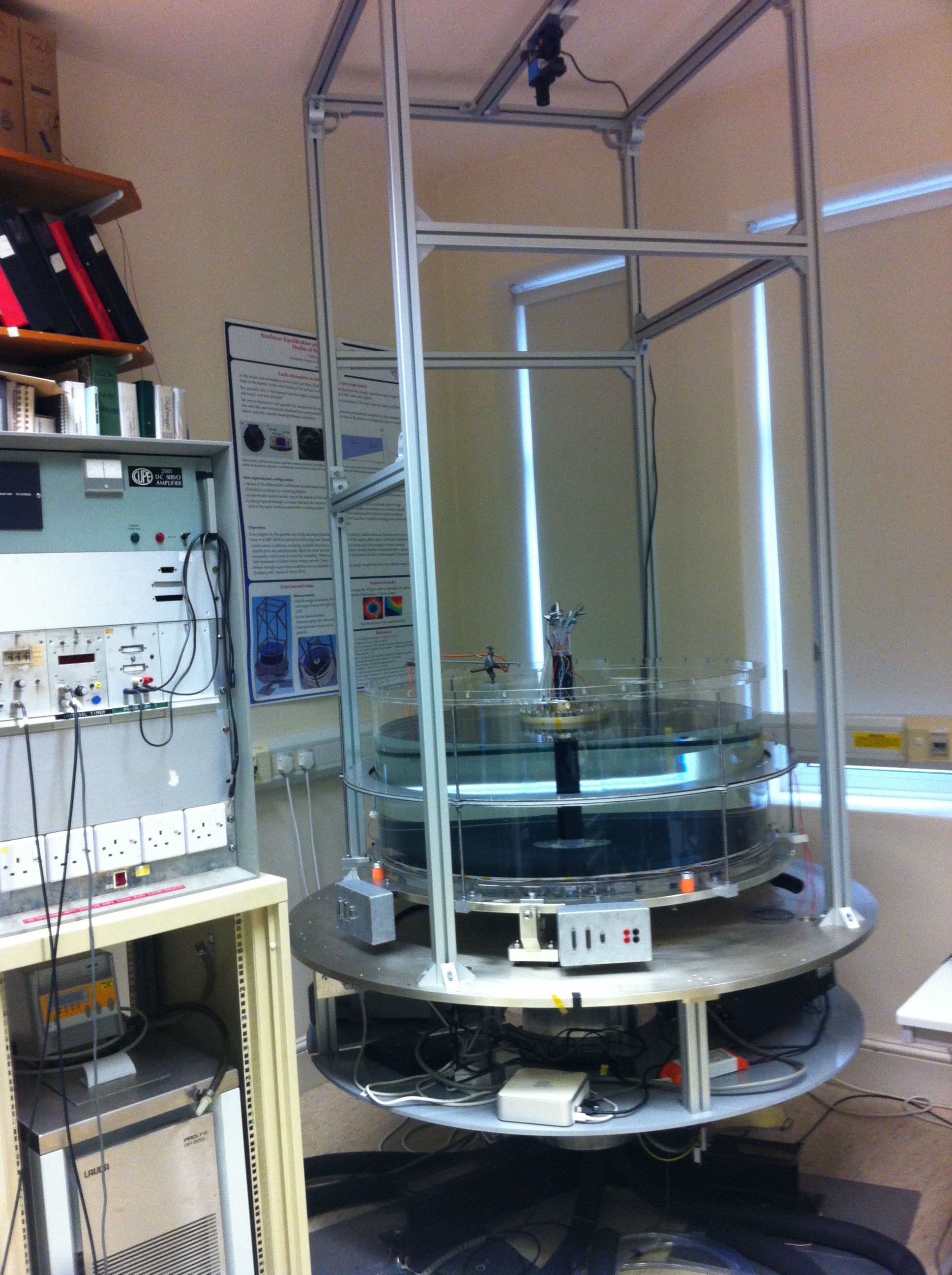

Schematic cross-section and design of the new experimental setup, variant of the differentially wall-heated annulus experiment.
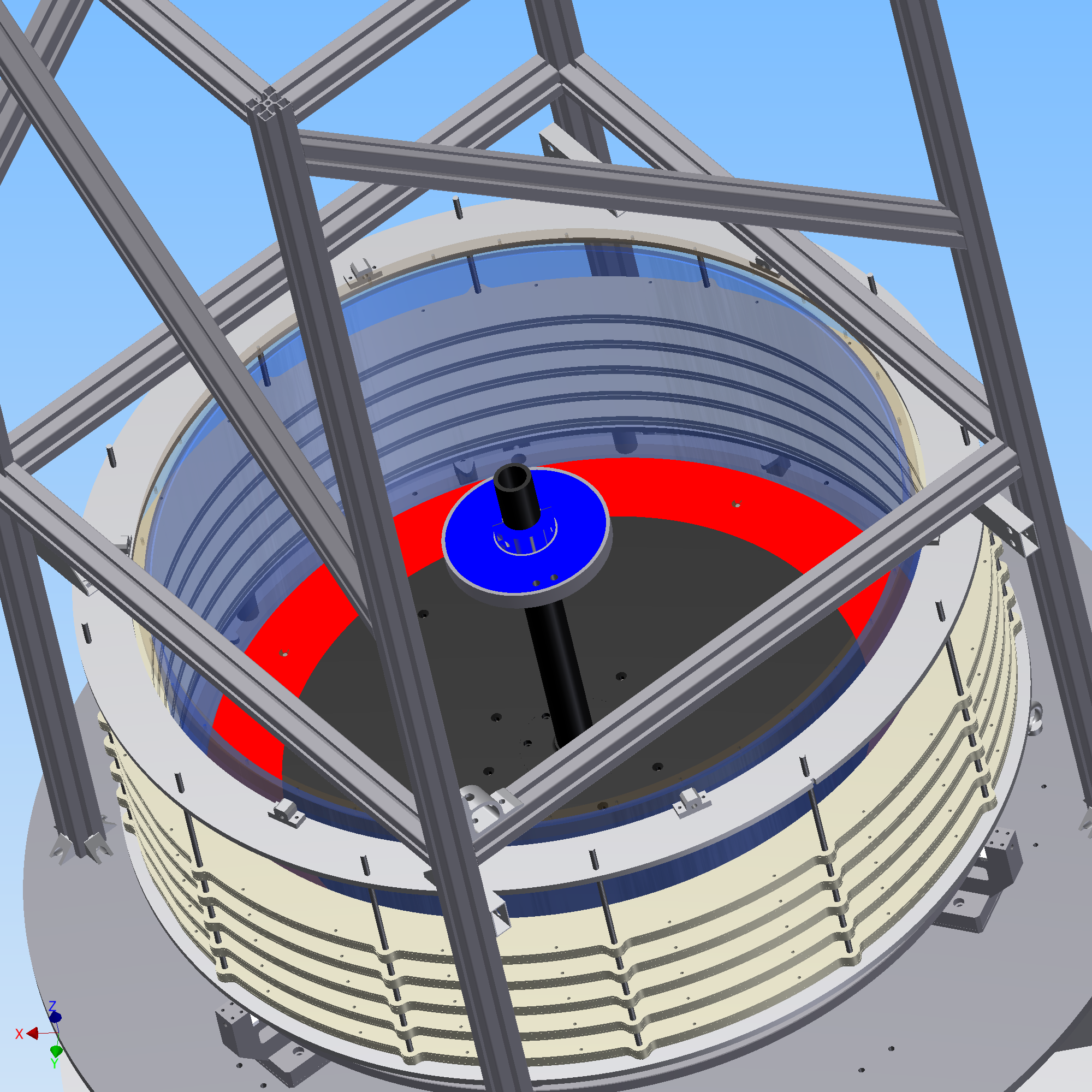
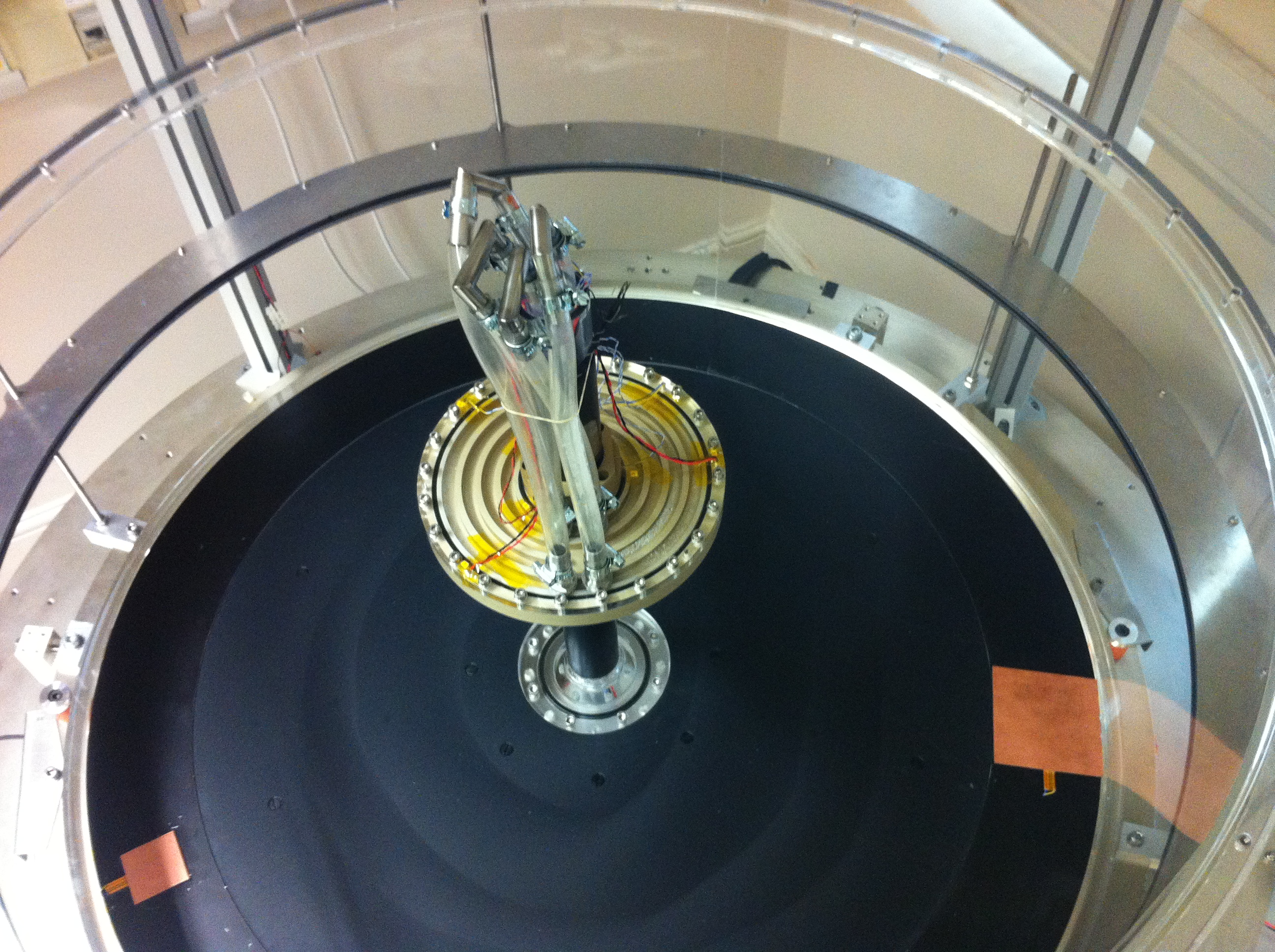
Experimental setup with an annular ring for the heat source and a cold plate at the center at the upper surface.
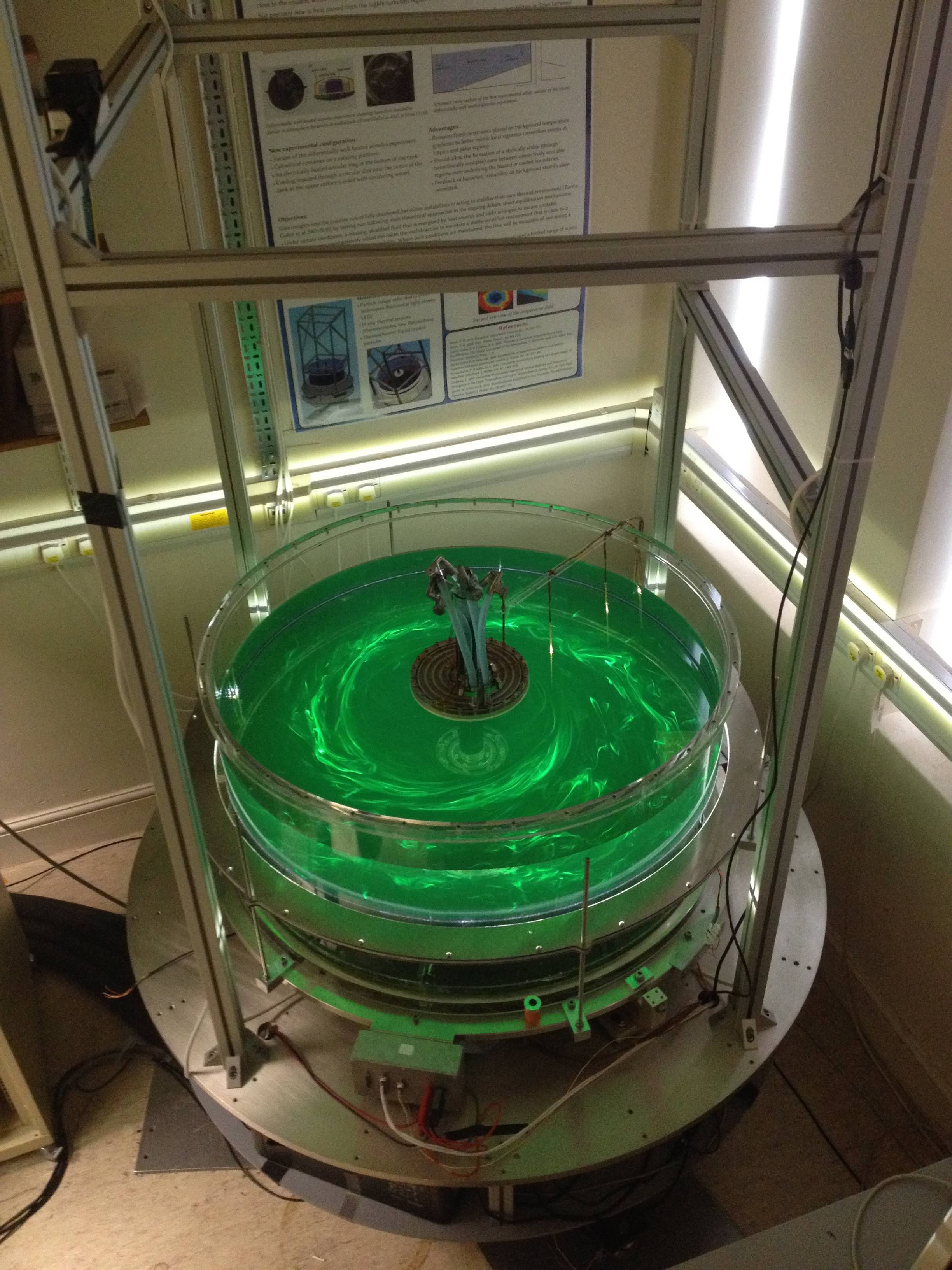
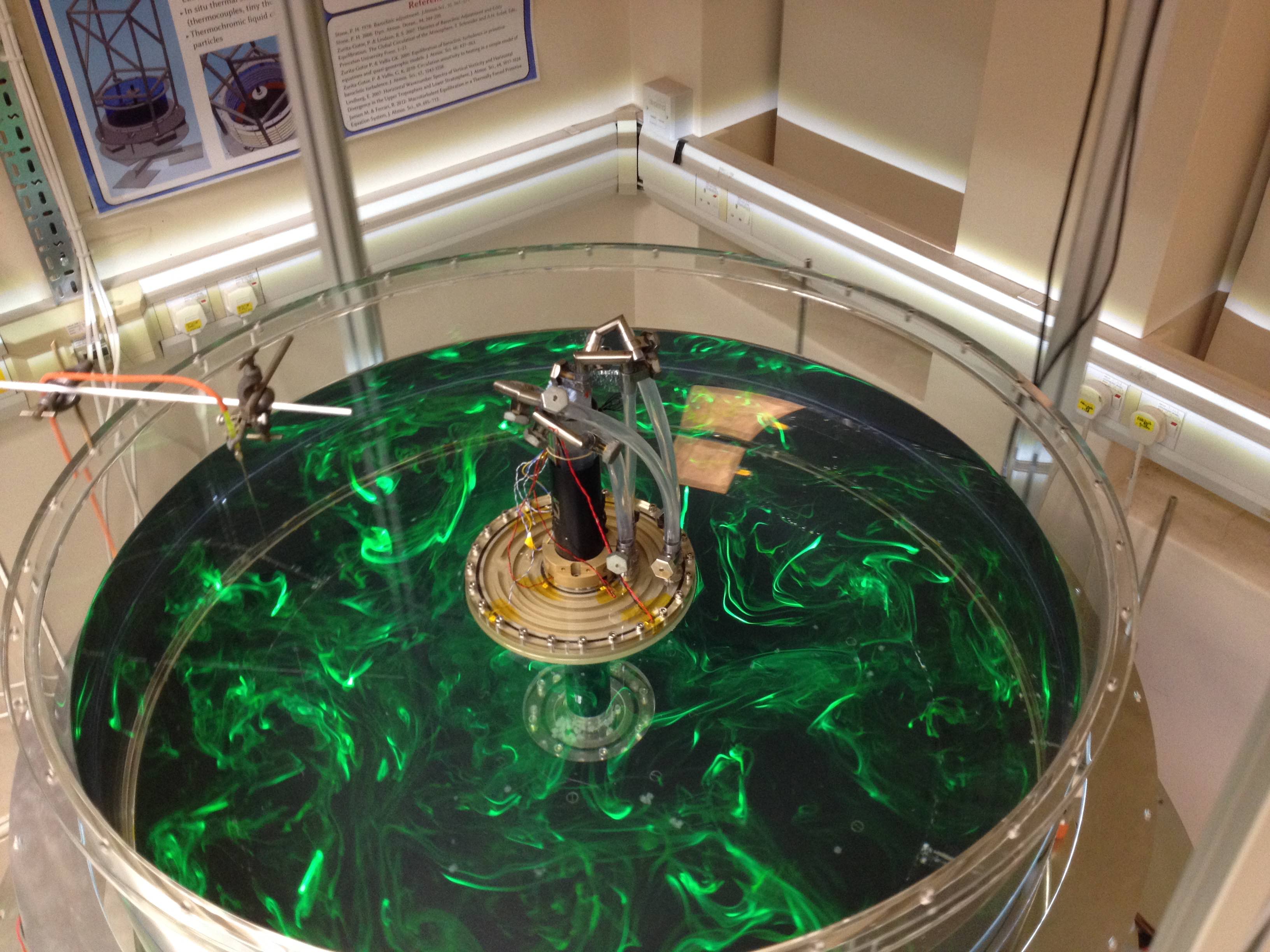
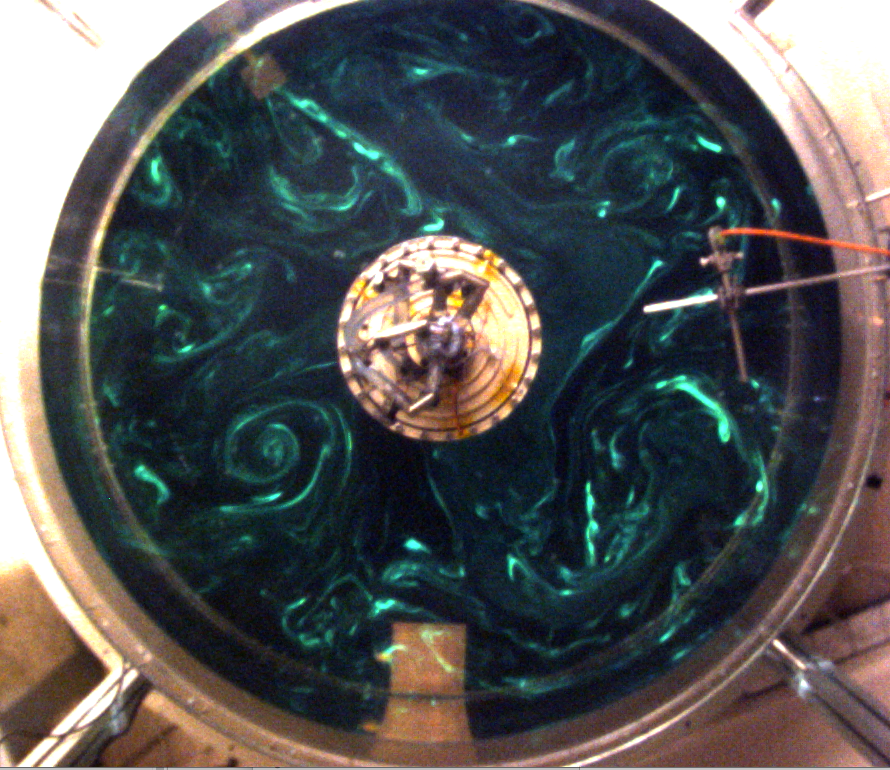
Example of baroclinic mode 1 (left) and mode 4 hightlighted with fluoresceine dye (right)
I will measure velocities and temperatures simultaneously within the flow with in situ thermal sensors and particle image velocimetry (PIV) techniques, possibly using thermochromic liquid crystal particles. This will allow to determine flow structures, heat and momentum transports within the flow, and to characterize the development of any kinetic energy cascades that may emerge as more turbulent regimes are explored.
Such a configuration may be seen as an idealisation of a variety of industrial processes (e.g. in rotating semiconductor crystal growth melts, process mixing techniques in chemical engineering, convective flows in turbomachinery etc.), and of a number of geophysical and astrophysical problems in which stably and unstably stratified flows interact in the presence of background rotation. These include the Earth's atmosphere and climate system and its response to variations in its radiative heating and cooling, other planetary atmospheres (notably Mars, Venus and the gas giant planets), and in stellar interiors (e.g. the tachocline region within the Sun).
Euhit "Waves, Turbulence and Diffusion in Beta-Plumes" (Beta-WTD) project
During my post-doc in Oxford, I also recently participated to the collaborative Euhit Beta-WTD project carried out at the Turin Rotating Platform facility Turlab , Italy. The main objectives of this project will be to explore, in a laboratory experiment designed to investigate forced-dissipative geostrophic turbulence on a topographic beta-plane, the validity and effectiveness of zonostrophic concepts under much more extreme conditions of nonlinearity than has been possible hitherto. Such concepts may be widely applicable to geophysical and astrophysical problems relating to the formation of jets in planetary atmospheres and oceans, and lead to parameterizations of energy, vorticity and material transport that can be directly tested in experimental measurements. Experiments are set up to form beta-plumes in a rapidly rotating fluid on a conical topographic beta-plane. Measurements will then be taken of the (Eulerian) horizontal velocity fields in order to obtain vorticity fields, from which energy transfer rates and lateral diffusion coefficients will be estimated. These will then be directly tested against simultaneous Lagrangian measurements of the dispersion of neutrally-buoyant tracer particles.
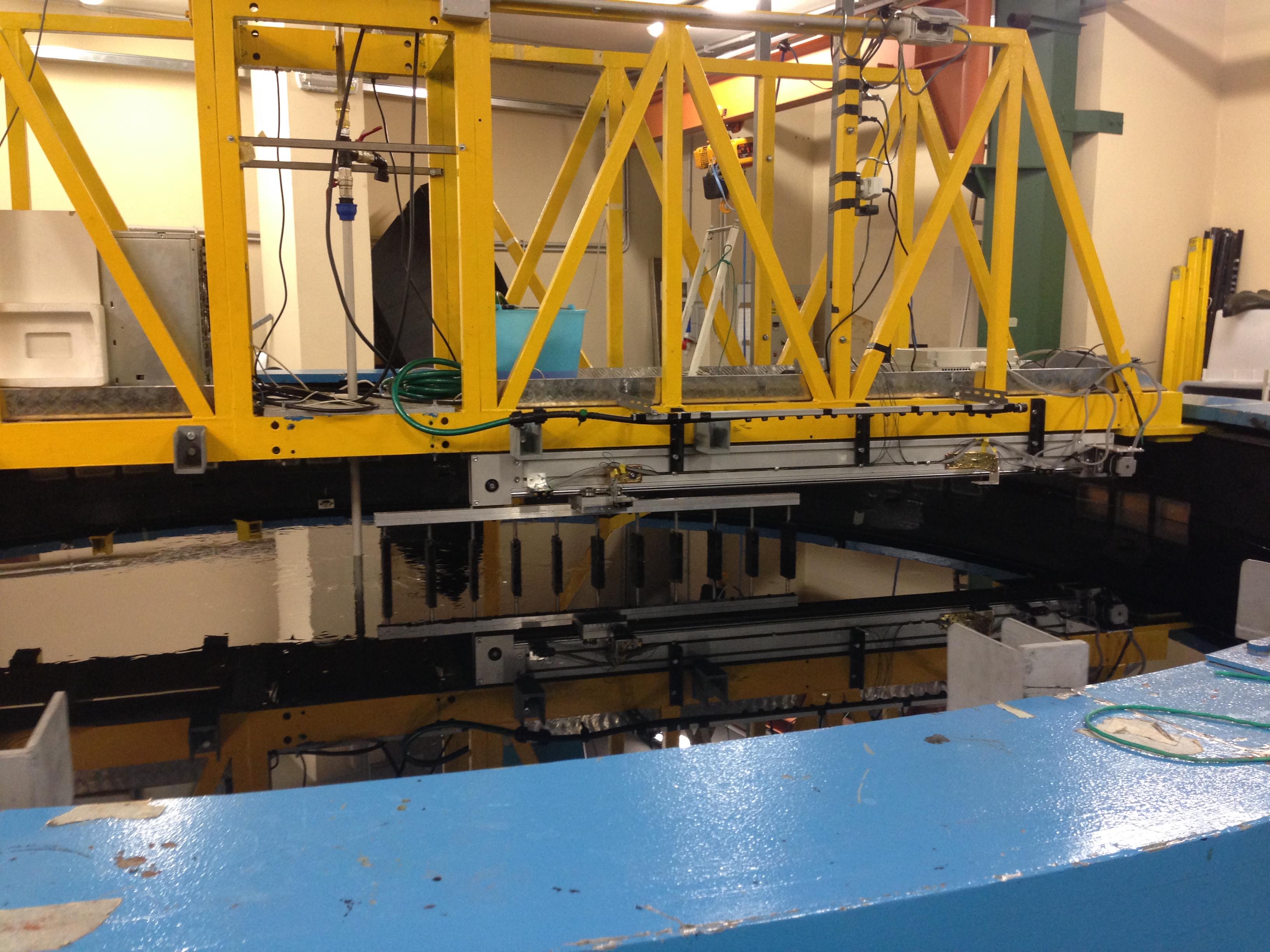
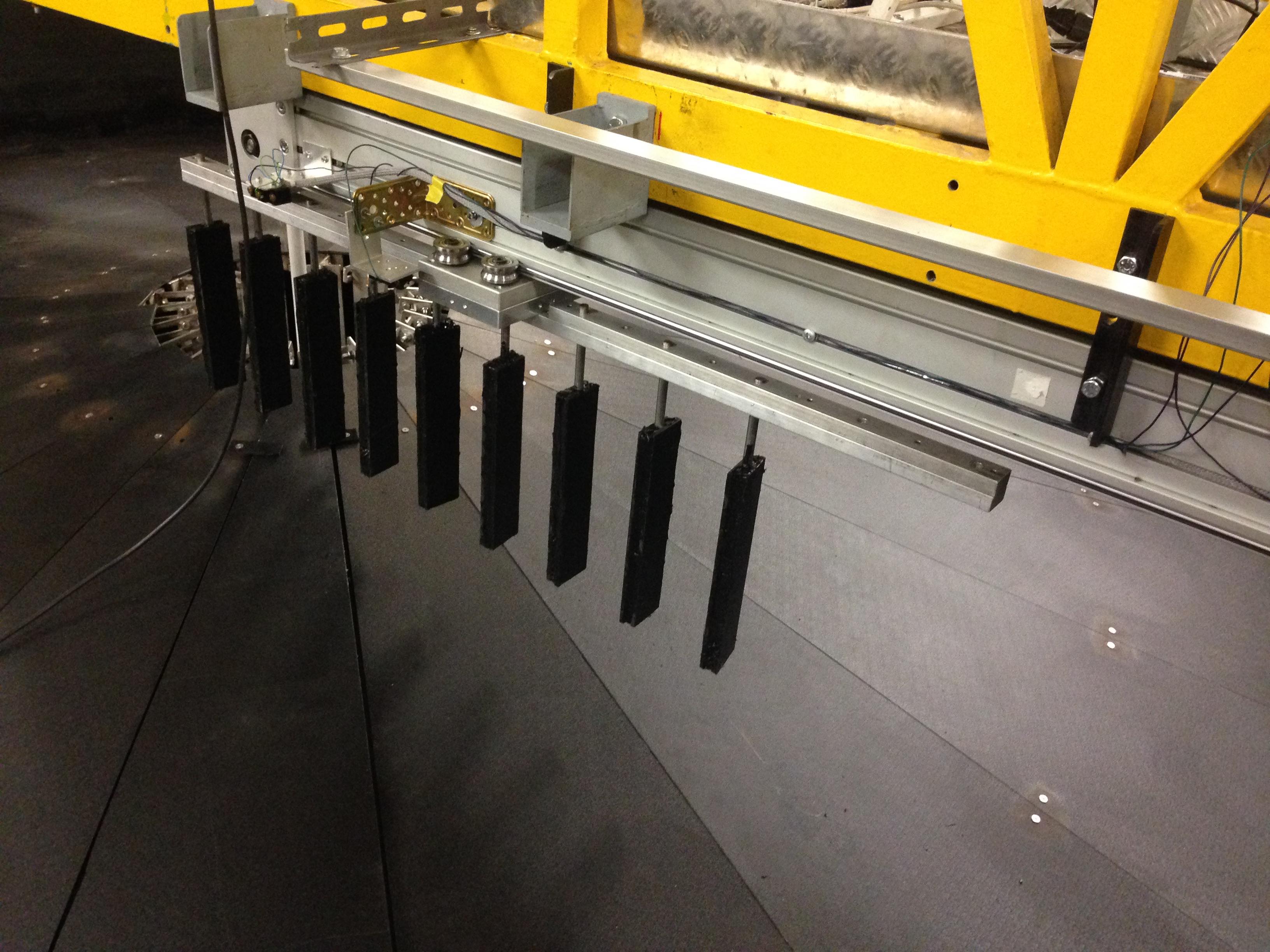
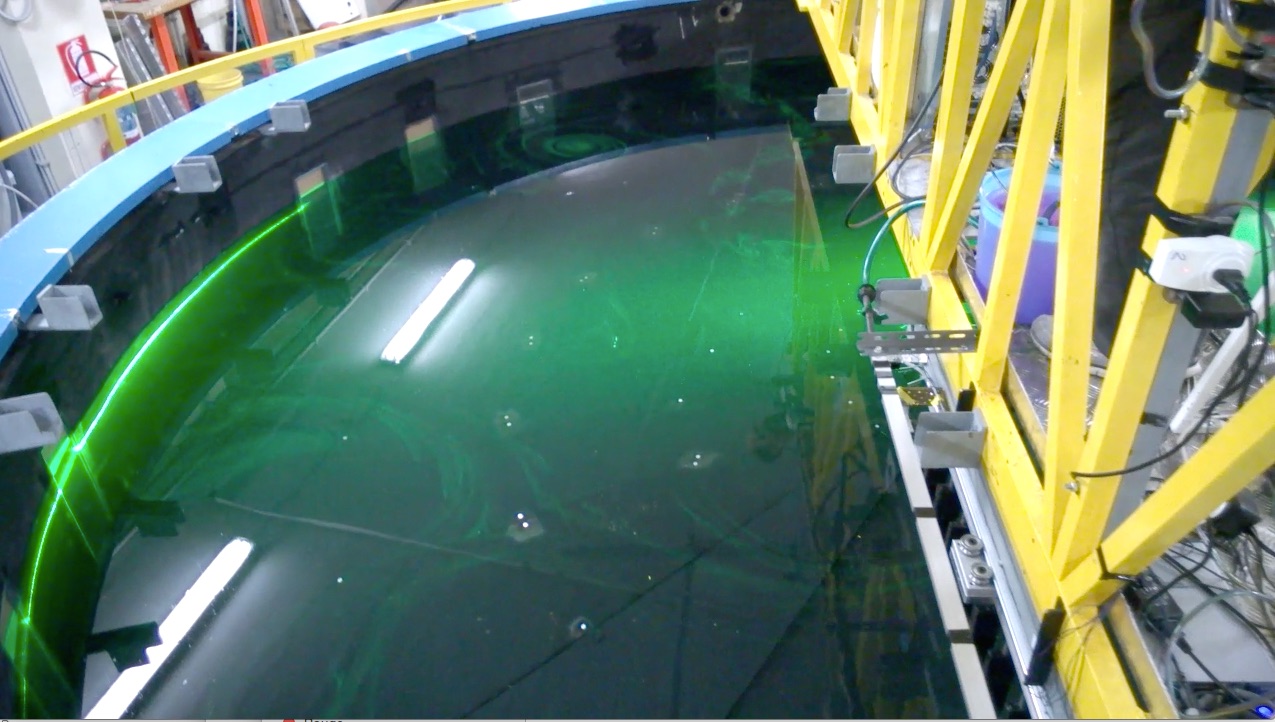
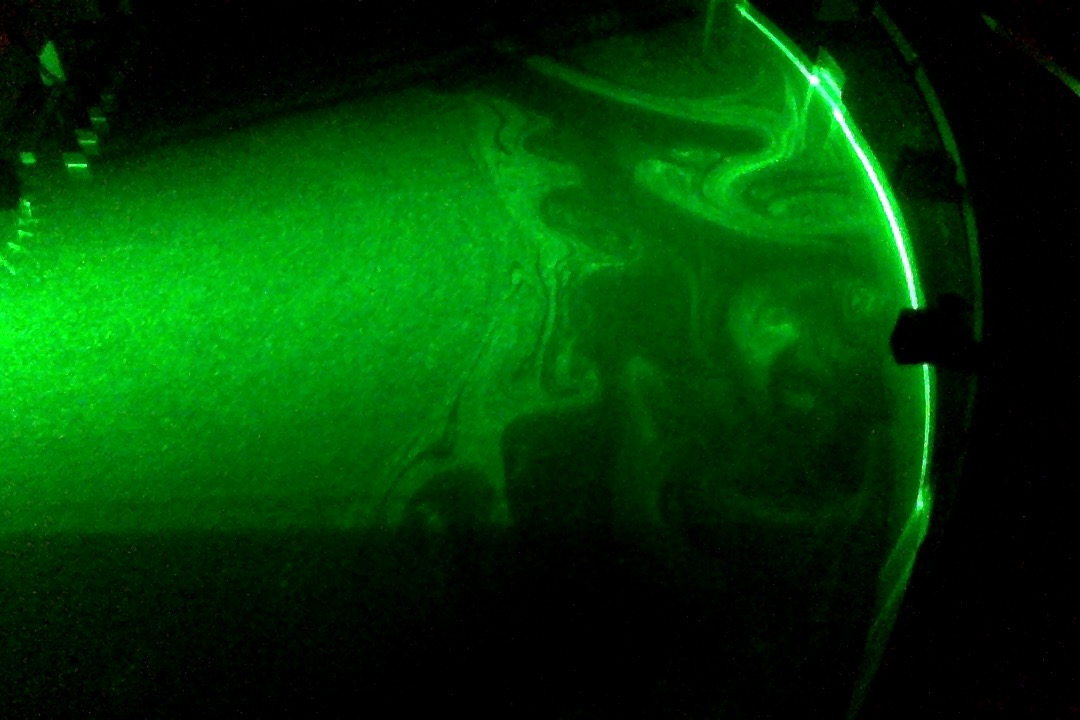
Left: set-up showing the forcing (translation of comb) in the rotating tank with conical bottom. Right: snapshots of dye and PIV experiments
Internal waves attractors
Internal waves are waves present in a stratified fluid (atmosphere or ocean) due to buoyancy force as restoring mechanism. In the ocean, internal waves are mainly excited by the tidal forcing on topographies. Understanding nonlinear dynamics of internal waves is essential to understand dominant mechanisms responsible of turbulent mixing in the ocean and to estimate the global energy budget of the ocean.
To this end, I carried out experiments in the ENS Lyon lab during my first post-doc to catch fundamental nonlinear dynamics features of internal waves.
My research work was a laboratory study on the instability of internal wave attractors in a trapezoidal fluid domain filled with uniformly stratified fluid. A standing-wave- type motion of a vertical wall is used to inject the energy. Attractors are found to be destroyed by parametric subharmonic instability (PSI) via a triadic resonance : it is a very efficient energy pathway from long to short length scales. Role of finite size effects on the development of this triadic instability was also investigated.
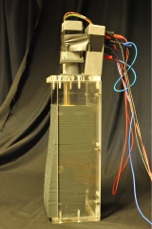
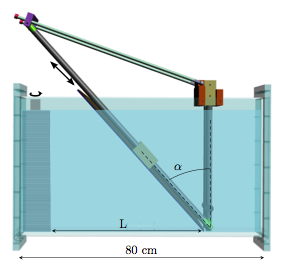
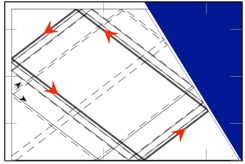
Generation of internal wave attractor with the ENS Lyon wavemaker and a slope system. Due to the sloping boundary, successive reflections of internal wave beams converge toward a closed trajectory as illustrated with the geometrical prediction of wave beam pattern.

Evolution of the wave internal attractor and parametric subharmonic instability visible on the focusing branch of the internal attractor near the slope (vertical density gradient field).
Dynamics and stability of fronts
From 2008 to 2011, I was a PhD student at the Laboratoire des Ecoulements Géophysiques et Industriels (LEGI) at Grenoble in France.
Here you can download my PhD manuscript, defended in December 2011.
My thesis dealt with the dynamics and the stability of fronts, within the general study of atmospheric and oceanic fronts and the origin of gravity waves in the atmosphere. Geophysical fronts (in atmosphere or ocean) are natural barriers with a strong density or temperature gradient and velocity gradient in a large-scale flow where both rotation and stratification are present.


Geophysical fronts : in the atmosphere, at mid-latitude in Europe or in the ocean on the Gulf Stream.
Fronts in the lab:
In this context we focus on a front in a rotating two-layer miscible fluid under vertical shear. Both experimental and numerical study highlights ageostrophic phenomena going beyond the usual geostrophic equilibrated configuration of a baroclinic front. First, the classification of different instability regimes of a front in an annular configuration as a function of Rossby number and Burger number reveals an ageostrophic instability coupling equilibrated and divergent motions due to a resonance between a Rossby wave and a Kelvin wave. This Rossby-Kelvin instability is confirmed numerically by the structure of the perturbation velocity fields in each layer. Second, small-scale structures have also been observed experimentally. Characteristics of the interface as a function of Richardson number and density and velocity interface thicknesses suggests the presence of the Hölmböe shear instability. A direct numerical simulation with an axisymmetric configuration and with a Schmidt number 700 confirms this conjecture. Other small-scale perturbations compatible with inertia-gravity waves have been observed numerically superimposed on an unstable Rossby-Kelvin front and the wave generation mechanism is discussed. In addition, a numerical study of a stable front highlighted the presence of internal Ekman layers with an additional interfacial structure in the case of high Schmidt number and small Rossby number. For fronts in in/outcropping, front dynamics is modified by the interaction with Ekman boundary layer at the location of the intersection zero-thickness singular point. It depends on both vertical circulation and mixing on the nose of the front and the various possible instabilities associated to horizontal or vertical wave resonances.
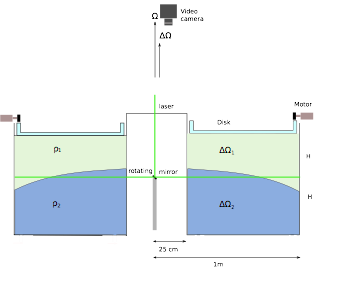
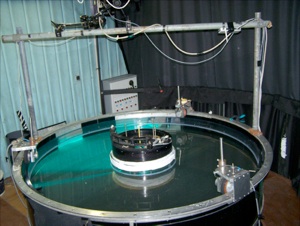
Experimental setup of the annulus rotating tank filled with two miscible layers and with differentially rotating disk at the top.
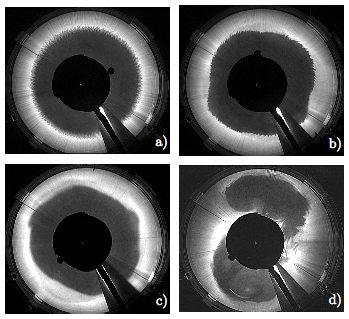
Observations (top view) of frontal instabilities: a) Hölmböe instability, b) mode 4 and mode 6 c) of the ageostrophic Rossby-Kelvin instability, d) barocline instability.
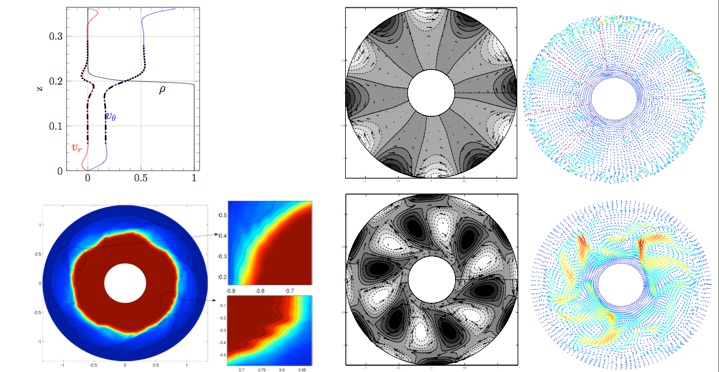
Numerical simulations in collaboration with R. Verzicco, confirming the Rossby-Kelvin instability with Kelvin wave structure in the lower layer and the Rossby wave structure in the upper layer (right up and down (perturbated velocity field). Left: Structures of internal Ekman layers in vertical profiles, and small-scale perturbations on the front (density field top view).
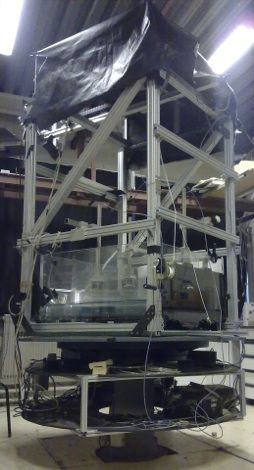
Experimental setup in cylindrical configuration.
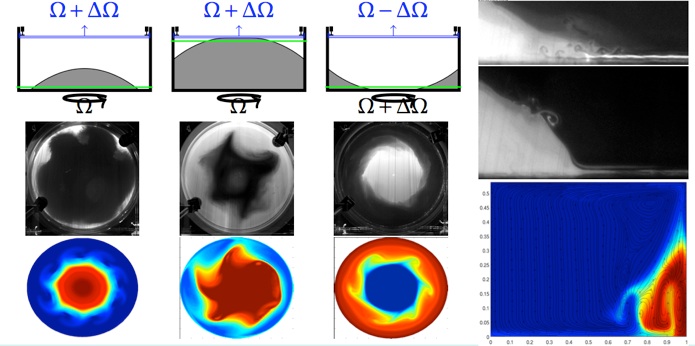
Dynamics of a front in intersection with an horizontal boundary: Rossby-Kelvin and barocline instabilities, distortion of the front and intense cyclones due to the presence of vertical walls. Lateral view: interaction of front with Ekman layers with overturning at the interface and convective plumes.
